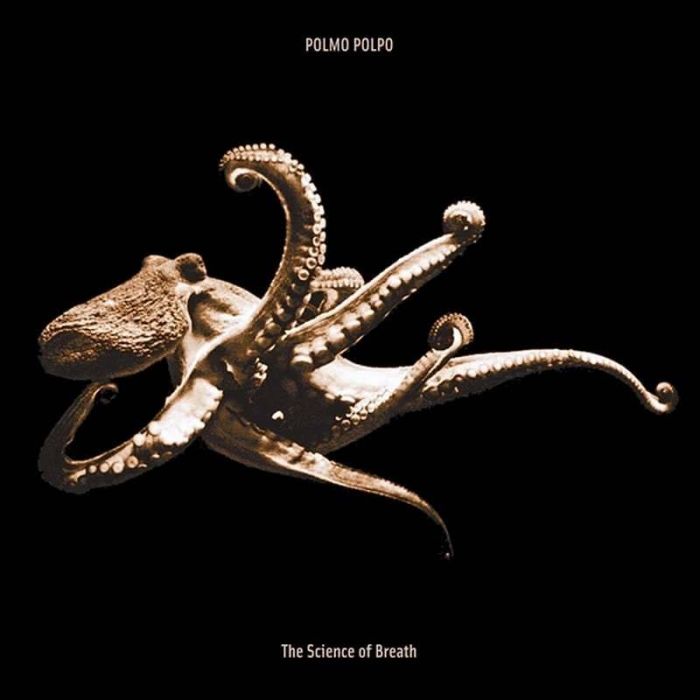The Science of Breath by Polmo Polpo (Review)

I love the sound of the lap steel. There’s just something in those rich, velvet tones that always tugs at my heart whenever I hear them. In my humble opinion, very few sounds on God’s green earth come close to matching the wistfulness and melancholy of those produced by this instrument.
Of course, when most people think of lap steel, they associate it with country music, which isn’t surprising. You could probably name the number of country songs that don’t feature lap steel on one hand. There’s something about the lap steel’s warm sounds that definitely conjure up images of wide-open spaces and whatnot, the perfect setting for a heartbroken country ballad.
However, when you mention “lap steel,” most people probably don’t think of minimal, glitch-ridden techno. Again, not too surprising. The sound of lap steel is a rather rustic one, and terms like “rustic” don’t usually fly too well with the laptop crowd. But that’s probably why the lap steel that weaves its way through Polmo Polpo’s dense, pulsating songs sounds so sweet.
There’s something ironic and beautiful about hearing a graceful lap steel soar and sway between the shifting waves of static and throbbing rhythms of “Acqua.” One imagines the grace of those tones extending to the rest of the piece, giving it a surprising warmth and lushness (again, words that aren’t readily associated with minimal techno).
At first, The Science of Breath sounds like its treading the same water as Pole, Pan American’s more dub-oriented works, and even some of Seefeel’s later output. Not that I’m complaining, mind you. The first 3 tracks do a tremendous job of submerging the listener in sound. As if you suddenly came across an alien industrial complex while surveying some ocean trench, you’re surrounded by all manner of muffled beats, pulsing static washes, and distant metallic drones.
The rhythmic net slowly grows more complex, constantly shifting and changing with the ocean current, with some new rich rhythmic construct seemingly emerging every minute or so. Given that “Oarca” lasts nearly 10 minutes, you might think that it gets rather stale halfway through. But Sandro Perri (who is Polmo Polpo) demonstrates considerable talent for keeping things interesting, creating a dense composition that becomes more fascinating the closer you look.
“Mid Breathing” takes the listener back towards the surface and straight into the dance club. “Acqua“ ‘s pulsating beat takes over, and instantly, the record kicks it into high gear. It’s here that the lap steel makes its first appearance, gracefully sidling in and making its presence felt with a few feathery tones.
While nearly all of The Science of Breath’s tracks are noteworthy in some regard, “Rottura” is undoubtedly the centerpiece. The song slowly builds on a beat that’s little more than pulse, and gradually layers on various electronic beeps and bleeps, gentle washes of static, ebbing guitar notes, and the lap steel’s siren song. Due to the guitarwork, there’s a constant sense of drift, as if the sonic layers might dissipate at any moment if not for the structure of that single pulse. As the song nears its end, the static grows more pronounced, eventually burying everything in a flurry of icy drones.
On Alien8’s website, they label “Rottura” as “one of the best pieces of minimal techno ever produced,” and I’m inclined to agree. It’s a beautiful and haunting track, and one that ultimately lingers with the listener long after The Science of Breath is over.
“Riva” ends the album on a high-stepping note, with a rolling beat that’s accented by the lap steel’s pendulum-like tones and an aggressive cello that descends and slices through the song’s closing minutes. Spaced between the longer tracks are shorter, more experimental interludes. “Mid Breathing” feels like it was recorded in an abandoned warehouse, as the sound of rain hitting the crumbling metal and concrete echoes through the empty halls. “Complete Breath” is more contemplative, with guitar creaks and drones slowly unfurling above a wet, glurpy pulse like the octopii that adorn the sleeve art.
Taken altogether, it makes for a stunning work that feels like a seamless blend of sounds that would normally be rather disparate. It might seem somewhat gimmicky to use lap steel in techno music, maybe akin to Tammy Wynette’s duet with the KLF. But there’s nothing gimmicky at all about Polmo Polpo’s lovely depths. Even after repeated listenings, I still find something intriguing everytime I descend.